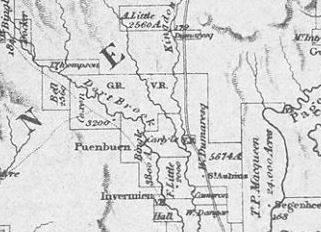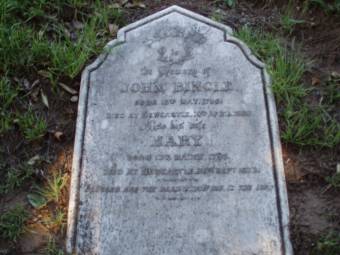John Bingle - Settler
Puen Buen - Map 9
John Bingle was about twenty-five years of age when arrived as second officer on the convict ship Minerva on 16th December 1821.
Image: John Bingle. State Library New South Wales
Very soon afterwards he embarked on a journey to Lake Macquarie with Rev. George Augustus Middleton.......
Our parson, the Rev. G.A. Middleton, (who was an especial favourite with the blacks) started with myself with the whole tribe of upwards of one hundred on a walking trip to Lake Macquarie; our necessary supplies, blankets etc they carried on their heads. On arrival I was enchanted with its beautiful scenery and can never forget it. The whole surrounding country and lake were serene and still, solitude reigned, no tree disturbed, and no trace of the white man's civilization, but all in it's natural wild state. We enjoyed all the wild sports of Australian bush life in it s primitive state as the Aborigines of that day (before they were contaminated with our vices) were accustomed to enjoy them. Shooting, fishing, kangarooing and hunting - our game was ample for us all. They supplied us also by diving, with the finest mud oysters for which the waters of the lake are noted, these we scalloped on our bush fires, and we spent five or six days of as much enjoyment as I ever had in any part of the world. [3]
Port Macquarie
John Bingle became partners with Robert Coram Dillon and together they established a Commercial business at No.2 Watt Street, Newcastle. In January 1822 John Bingle received instructions from Governor Brisbane - to proceed on the Sally to Port Macquarie and then to sail in search of a large River supposed to exist between Port Macquarie and Sandy CapeNewcastle
The business of Bingle and Dillon was dissolved by 1824. Allotment 2 in Watt Street Newcastle abutted to Lot 1 at the rear. It was sold in 1828 to Philip Cavenagh and John Robson who were merchants of Sydney. [1]When they sold the allotment that same year to Frederick Boucher of Newcastle there was already a dwelling house, warehouse and other buildings erected on the site. Boucher conveyed it to J.B. Bettington in 1830 and in 1835 Bettington sold to James Reid of Newcastle.
Puen Buen
John Bingle acquired 1800 acres named Puen Buen in the 1820's. He later moved to England, returning to Australia in 1842. He sold Puen Buen to John Robertson, son of James Robertson and later returned to Newcastle.John Bingle enjoyed the lifestyle of a minor member of the colonial squattocracy, playing a prominent part in the development of the local district, serving on the bench of magistrates and waging war against bushrangers. In later life, he compiled a fascinating, illustrated account of these years for his memoirs - [4] [Squatters Reminiscences - State Library of New South Wales]
Death
He died aged 80 on 10th April 1882. He was highly respected and flags were flown at half mast at Newcastle in his honour.
Gravestone of John Bingle - Newcastle Cathedral Burial Ground -
The following convicts were assigned to John Bingle at Puen Buen.
Search here to find out more about each convict
Charles Dix Isabella 1832
Margaret Doyle - Palambam 1831
William Bean/ McBean - Isabella 1832
William Smith - Georgiana 1831
Charles Shepherd - Portland 1832
John Anderson - Speke 1826
William Henry Jones - Mary 1833
Patrick Arnold Dorothy 1820
Benjamin Cordell - Earl St. Vincent 1820
William Smart - Asia 1825
Jesse Coleman - Midas 1827
Rachael Davies - Lord Sidmouth 1823
Thomas Hollands - Grenada 1827
Thomas Kairnan - Hooghley 1825
Francis Norris - Hercules 1825
Elizabeth Bullard - Burrell 1832
Margaret McConnell - Diana 1833
Samuel Dawes - Strathfieldsaye 1836
Thomas Burley - Hadlow 1818
William Carlyle - Anne and Amelia 1825
Thomas Neaves - Norfolk 1837
William Nuttall - Hercules 1832
George Newman - Royal Sovereign 1835
Joseph Poe - Calcutta 1837
Thomas Morgan - Prince Regent 1827
William Springall - Portland 1832
Henry Hughes - Royal Admiral 1830
John Wilson - Georgiana 1831
Henry Wright - Susan 1834
Edward Cussan - Backwell 1835
John Budgell - Lady Kennaway 1836
John Webb - Susan 1834
Adam Baxter - Mangles 1833
John Tuckey was employed as overseer at Puren Buen in the 1830's. Select here to read about some of the punishments dealt out during his time as overseer.
Notes and Links
1. John Bingle's daughter Sarah married William Little of Invermein in 1858 - Design and Art Australia Online - Biography of John Bingle's daughter Sarah Cross Little2. Reminiscences of Edith Alice Little granddaughter of John Bingle - Australian Women's Weekly
3. John Bingle's Personal Copy of the Past and Present Records of Newcastle New South Wales (1873)
4. Sir Thomas Livingstone Mitchell passed through the Upper Hunter area in 1831. He conversed with the aboriginal tribe from the Puen Buen area.
5. Article from the Newcastle Morning Herald on the 100 year anniversary of the arrival of John Bingle in Australia....
Captain John Bingle, who arrived in Australia 100 years ago to-day as an officer of the ship Minerva, and whose name is identified particularly with the Hunter River, was born in Gillingham, Kent, England, on the 15th May, 1796, his people having been for many years naval architects and associated with the construction of the ships of the line, frigates, etc., built at the dockyards at Chatham and Deptford.
Brought up in these surroundings, it was not strange that he went to sea, first in the Honorable East India Company's service, and afterwards in the navy. The Minerva (Captain Bell), in which he came to Australia, as a junior officer, took six months on the voyage, and brought 169 male prisoners under a military guard commanded by Lieutenant Hingston.
Young Bingle left the vessel at Sydney, and seems to have been immediately commissioned by the Governor, Sir Thomas Brisbane, to take command of H.M.S. cutter Sally, and survey the coast, and especially to look for a large river believed to exist north of Port Macquarie. The Sally, after calling at Newcastle, seems to have met with bad weather, and we next hear of her arrival in January, 1822, in Moreton Bay, Queensland. It is recorded by Captain Bingle that the blacks there had never seen a white man and were amazed at his white skin, boot prints, firearms, etc. The Governor gave Captain Bingle a certificate expressing appreciation of the survey operations carried out by him.
Captain Bingle would then appear to have retired from His Majesty's services, as he applied to the Government and obtained leave to build a vessel for the coal trade between Newcastle and Sydney. In 1824 this vessel, the Eclipse, while lying at anchor, was cut out by a gang of convicts, ran away with, and nothing more was ever heard of her or her crew.
Captain Bingle then became a squatter at Puen Buen on the Dartbrook, Scone, and as a most active magistrate and public spirited citizen, had exciting experiences with the turbulent spirits of the district, being instrumental in chasing and bringing bushrangers to justice. At one meeting of the Scone Bench of Magistrates, of which he was chairman, no less than six bushrangers were sentenced.
He claimed to have been the first white person, except perhaps an escaped convict or two, on the Liverpool plains. One day, riding by the Wollombi route to Sydney from Hunter River, he stopped to water his horse at a small pool, and was surprised when a couple of kangaroo dogs came out to him, as he could not see any human beings. Shortly afterwards a bushranger in gaol sent for him, and reminded him of the incident, saying, 'I saved your life then, as my mate had you covered with his gun, but I pulled him down, so I think you ought to do something to help me now.' Captain Bingle did, and was successful in getting him a reduced sentence.
Droughts, which were even worse then than now, caused Captain Bingle to sell out his pastoral interests, and to start business as a merchant, tug owner, etc., in Newcastle, New South Wales. His name is identified with practically every one of the movements in the early days for the advancement of the city and district. He was chairman of the first Chamber of Commerce in 1856, and built up a large business with nearly every part of the world. He was the designer of the Coat of Arms of the City of Newcastle and was also responsible for the adoption of the New South Wales flag, the white ensign with the blue cross and stars. He remained in Newcastle until his death at the age of 86, and was buried in the Cathedral graveyard overlooking the city.
About 70 of his descendants are scattered about Australia and New Zealand, including Mr. John Bingle, manager of the head office of Melbourne Commercial Bank of Australia, and Mr. Walter Bingle, the permanent head of the Commonwealth Department of Works and Railways. - Newcastle Morning Herald and Miners' Advocate Fri 16 Dec 1921
References
[1] Cadell, F.A., A Survey of Newcastle, Royal Australian Historical Society, 1936 p.387[2] Colonial Secretary's Papers, 1788-1856 Copies of Letters Sent Within The Colony, 1814-1827
[3] Bingle, John, 1796-1882. Past and present records of Newcastle, New South Wales, Newcastle [N.S.W.] : Bayley, Son and Harwood, 1873.
[4] Squatters Reminiscences - State Library of New South Wales.
↑
